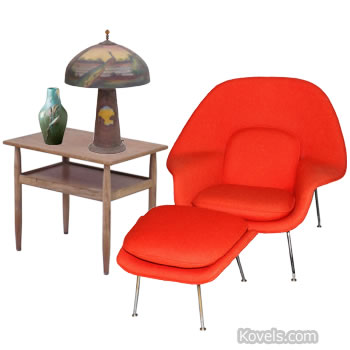Selling at auction has changed in the last five to 10 years. Today auction galleries attract more “retail” clients—buyers who are not dealers. They are bidding and buying to decorate or furnish their own homes.
It’s often said that most items come to the auction market because of death, divorce, disaster or downsizing. Before the advent of online sales, most auctions were attended mainly by dealers trying to buy at wholesale prices so they could resell the antiques at a show or shop. Auctions aren’t as “wholesale” as they used to be, which is a big boon to sellers.
Amelia Jeffers of Garth’s Auctioneers and Appraisers near Columbus, Ohio, explained: “Retail buyers had made up about 10 percent of the buying audience at Garth’s. We are now up to about 30 to 40 percent, which of course helps [raise] prices. We work hard to attract, cultivate and improve interest from every category of buyer, and we strive to provide a bidding environment that is not only welcoming, but transparent and full of integrity.”
Collectors in the past often wanted large collections of related items. Assorted English cups and saucers, dozens of examples of carnival glass in different patterns, shelves of Hummel or Royal Doulton figurines or Christmas plates. Some liked to exhibit rows of old tobacco tins or even a full “country store” filled with antique packaging. Today most decorators and young collectors want fewer but larger and more unusual decorative figures or vases or even chairs or tables—the highest quality in limited numbers.
More collectors are going to auctions and sales to buy what they like, not what a decorator advises. They can do research easily and on their own, they can find hundreds of pictures of antiques and marks online, and they can quickly become amateur experts ready to make specific targeted selections. So they go to an online auction, study the catalog, call to ask questions about condition or history, and bid by email or phone.
These middle-market collectors—unlike the super wealthy who consult experts and then buy fine art worth hundreds of thousands of dollars—create their own displays of old bottles, advertising signs or art pottery. And they learn a lot and have fun along the way.
Pictured: Eero Saarinen upholstered womb chair and ottoman, sold by Dumouchelles for $3,998; a Vitze teak side table, Susanin’s Auctions, $96; Ephraim Milkweek vase, Michaan’s Auctions, $148; and table lamp with reverse-painted panel and shade, unsigned, Susanin’s, $480.




Leave a Reply
You must be logged in to post a comment.